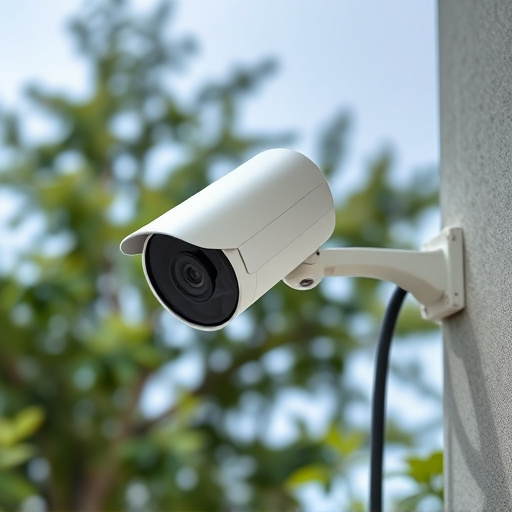Understanding the design and strategic placement of outdoor dummy cameras is crucial for deterring intruders and enhancing security. Before installation, carefully evaluate the mounting location for clear visibility, sturdy surfaces, and minimal obstructions. Follow a meticulous process to assemble the camera and bracket, ensuring proper alignment and security. Secure the mount using suitable adhesives or hardware, then perform final checks on cable, power, functionality, and settings for optimal performance of these deterrent security solutions.
“Uncover the secrets to installing an outdoor dummy CCTV camera with our comprehensive guide. This step-by-step tutorial is designed for DIY enthusiasts aiming to enhance home security. From understanding your camera’s components to final testing, we’ll navigate you through each phase. Learn how to prepare the mounting location, assemble the camera and mount securely, and perform crucial final checks. Master these outdoor dummy CCTV installation steps and take control of your property’s safety today.”
- Understanding Your Outdoor Dummy Camera
- Preparing the Mounting Location
- Assembling the Camera and Mount
- Securing the Mount to the Surface
- Final Checks and Testing
Understanding Your Outdoor Dummy Camera
Understanding your outdoor dummy camera is a crucial first step in the installation process. This type of security camera mimics real CCTV equipment, designed to deter potential intruders while providing a sense of safety for your property. Before mounting, familiarize yourself with its components: housing, lens, LED indicators, and power cable.
Following meticulous planning, you can now move on to the outdoor dummy camera installation steps. Ensure a secure location by selecting a spot that offers clear visibility of entry points and potential threats. The right height and angle are critical for optimal view, so consider your surroundings carefully. Remember, proper placement enhances its deterrent effect while ensuring the camera captures valuable footage if needed.
Preparing the Mounting Location
When preparing for the outdoor dummy camera installation, ensuring the mounting location is suitable is step one. This involves assessing the area where the fake CCTV will be placed. Look out for potential obstacles that could hinder its visibility and access, like large trees or structures that might block line-of-sight. The surface should also be sturdy enough to support the weight of the camera setup, typically a requirement for any outdoor security system.
It’s crucial to choose a spot with adequate lighting, as this enhances the dummy camera’s effectiveness as a deterrent and ensures clear visuals during inspections. Once the ideal location is identified, clear the area of any debris or objects that might interfere with its installation, following best practices for an Outdoor Dummy Camera Installation Steps.
Assembling the Camera and Mount
When assembling your outdoor dummy camera, follow these meticulous steps for a seamless installation process. Begin by carefully unboxing all components—the camera body, mounting bracket, and any necessary accessories. Ensure every piece is accounted for to avoid any disruptions during setup. Next, attach the camera securely to the mount by aligning the camera’s base with the designated slots on the bracket. Use the provided hardware to fasten the connection firmly in place, ensuring stability against external forces.
Once the camera is safely secured, assemble the mounting bracket according to the manufacturer’s instructions. This may involve tightening screws or adjusting components for optimal positioning. Ensure the bracket is level and aligned correctly with your desired viewing angle. With a sturdy foundation established, you’re now ready to position your outdoor dummy camera at the chosen location, offering clear line-of-sight for effective surveillance.
Securing the Mount to the Surface
Securing the mount to the surface is a crucial step in the outdoor dummy camera installation process. Begin by ensuring the area is clean and free from debris, as this will ensure a strong bond between the mount and the chosen surface. For solid, flat surfaces like walls or posts, use high-quality adhesive designed for outdoor use to attach the mounting bracket. Follow the manufacturer’s instructions carefully for optimal results.
If the surface isn’t suitable for adhesive, consider using screws or bolts instead. Drill pilot holes to prevent cracking and ensure the mount is securely fastened. Always use weatherproof fasteners and seal any gaps to protect against the elements. Properly securing the mount will guarantee your dummy camera remains in place, deterring potential thieves while providing peace of mind.
Final Checks and Testing
After completing the physical installation, it’s crucial to perform final checks and testing for a seamless Outdoor Dummy Camera setup. Verify that all cables are securely connected, with no exposed wires, ensuring the camera’s power supply is stable. Check the camera’s functionality by powering it on and reviewing the feed on your monitoring system. Ensure clear visibility and optimal image quality. Test the motion detection sensors by triggering them manually to confirm their sensitivity and reliability. This step is vital in identifying any potential issues before full operation, ensuring a smooth and effective security solution.
Remember that proper calibration of the camera’s settings, including field of view and resolution, will enhance its performance. Additionally, checking the mounting stability ensures the camera won’t shift or become loose over time, which could impact its accuracy and overall effectiveness as an Outdoor Dummy Camera Installation Step.
Installing an outdoor dummy camera is a straightforward process that involves careful preparation and assembly. By following these simple steps, from understanding your equipment to final testing, you can effectively secure and position your fake CCTV camera to deter potential intruders and enhance your home’s security. Remember, the key to successful installation lies in meticulous planning and attention to detail during assembly and mounting.
